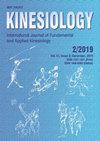Bilateral deficit: relationships with training history and functional performance
IF 0.9
4区 医学
Q4 REHABILITATION
引用次数: 4
Abstract
The purpose of the study was to investigate the magnitude of bilateral deficit (BLD) in trained males and examine its relationship with functional performance and recent resistance training history. Ten physically active males (age: 23.02±1.27 years) self-reported the number of unilateral and bilateral exercises within their structured resistance training schedule. During two visits to the laboratory, participants performed unilateral and bilateral squat jumps (SJ) and isometric leg extensions (ILE) for the quantification of BLD. Participants also performed bilateral countermovement jumps (CMJ) and a change of direction (COD) test to quantify functional performance. The performance outcomes and information regarding training history were then correlated with the bilateral index (BLI) metric. The key findings were that: (a) a lower BLD in SJ peak power related to a greater CMJ peak force (r=.728; p=.02) and peak power (r=.750; p=.01), (b) the BLI in the ILE was unrelated to performance outcomes, and (c) BLI was unrelated to the mean number of bilateral and unilateral exercises in the structured resistance training programme of participants. In conclusion, lower levels of BLD may be advantageous for bilateral tests of functional performance (i.e. jumps) however there is a need to consider the mechanical similarity between the performance and BLD measure. Finally, the balance of unilateral and bilateral exercises in an individual’s recent resistance training history is not sensitive to the BLI measured during dynamic or isometric assessments.双边赤字:与训练历史和功能表现的关系
本研究的目的是调查训练男性双侧缺陷(BLD)的程度,并检查其与功能表现和近期阻力训练史的关系。10名身体活跃的男性(年龄:23.02±1.27岁)在结构化阻力训练计划中自我报告单侧和双侧练习的次数。在两次实验室访问期间,参与者进行了单侧和双侧深蹲跳(SJ)和等距腿伸展(ILE),以量化BLD。参与者还进行了双侧反动作跳跃(CMJ)和方向变化(COD)测试,以量化功能表现。然后将表现结果和有关训练历史的信息与双边指数(BLI)指标相关联。主要发现有:(a) SJ峰值功率较低的BLD与较大的CMJ峰值力相关(r=.728;P =.02)和峰值功率(r=.750;p= 0.01), (b) ILE中的BLI与表现结果无关,(c) BLI与参与者在结构化阻力训练计划中的双边和单侧练习的平均次数无关。总之,较低的BLD水平可能有利于功能性能(即跳跃)的双边测试,但需要考虑性能和BLD测量之间的机械相似性。最后,个体近期阻力训练历史中单侧和双侧运动的平衡对动态或等距评估中测量的BLI不敏感。
本文章由计算机程序翻译,如有差异,请以英文原文为准。
求助全文
约1分钟内获得全文
求助全文
来源期刊

Kinesiology
REHABILITATION-SPORT SCIENCES
CiteScore
1.90
自引率
8.30%
发文量
16
审稿时长
>12 weeks
期刊介绍:
Kinesiology – International Journal of Fundamental and Applied Kinesiology (print ISSN 1331- 1441, online ISSN 1848-638X) publishes twice a year scientific papers and other written material from kinesiology (a scientific discipline which investigates art and science of human movement; in the meaning and scope close to the idiom “sport sciences”) and other adjacent human sciences focused on sport and exercise, primarily from anthropology (biological and cultural alike), medicine, sociology, psychology, natural sciences and mathematics applied to sport in its broadest sense, history, and others. Contributions of high scientific interest, including also results of theoretical analyses and their practical application in physical education, sport, physical recreation and kinesitherapy, are accepted for publication. The following sections define the scope of the journal: Sport and sports activities, Physical education, Recreation/leisure, Kinesiological anthropology, Training methods, Biology of sport and exercise, Sports medicine and physiology of sport, Biomechanics, History of sport and Book reviews with news.
 求助内容:
求助内容: 应助结果提醒方式:
应助结果提醒方式:


